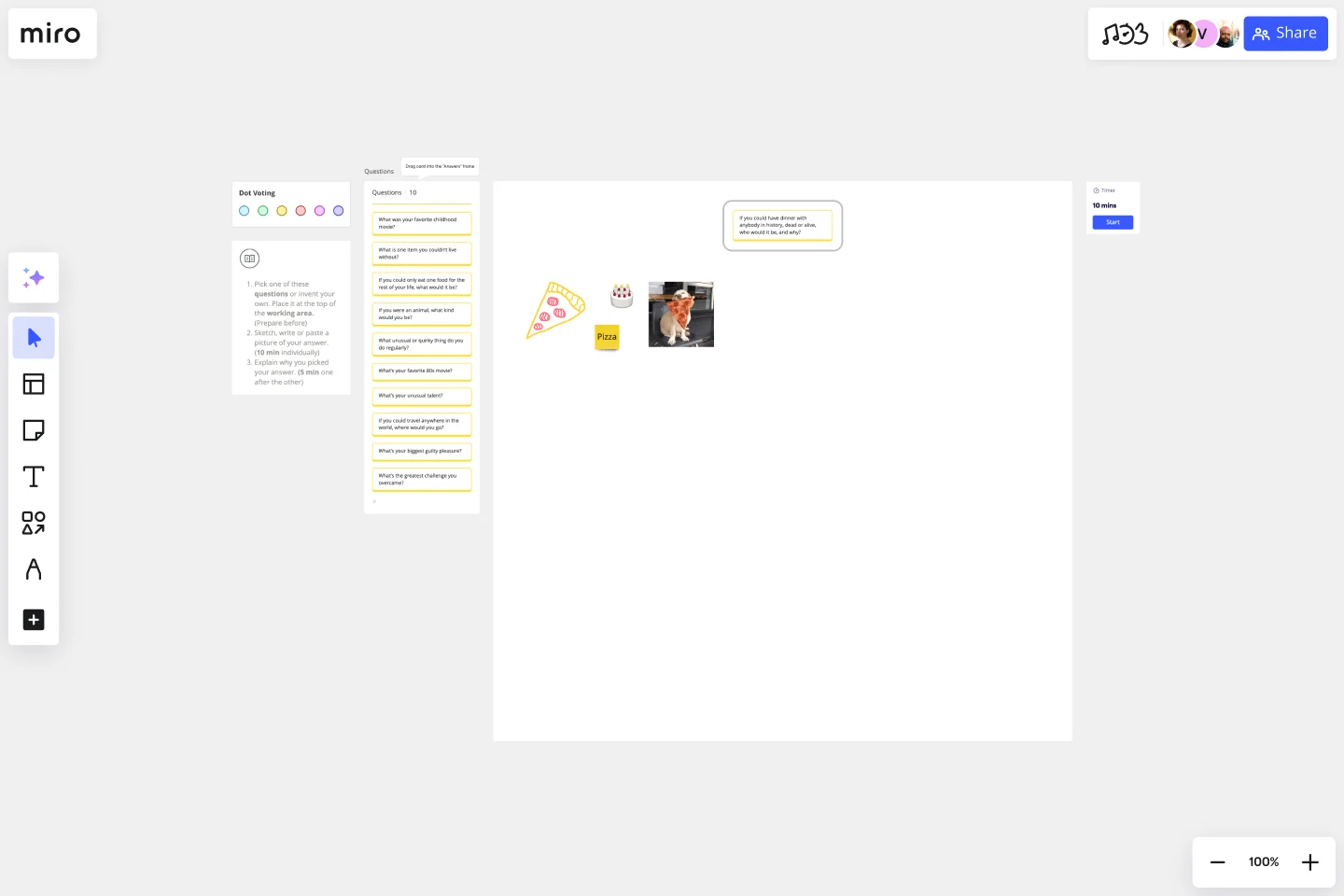Icebreaker Template
Start your remote meeting right, build trust, and get to know each other.
About the Icebreaker Template
When new people join a company or a team, it can be hard for everyone to get to know each other. This is especially true for remote and distributed teams. Icebreakers are games, activities, questions, or events that are used to get people comfortable with each other and bring everyone together. Effective icebreakers can warm up a conversation, reinforce the topic of discussion, and ensure that everyone is engaged in a session.
Looking for new ideas for icebreakers? Read our blog on 27 icebreakers great for remote and in-house team building.
How do you use the icebreaker template?
First, pick a question and place it in the working area of your icebreaker template. Then, sketch, write, or paste a picture with your answer. When everyone is done, ask for each team member to explain their answer and also share yours.
When should you use an icebreaker?
Icebreakers can be used to add energy to any meeting. They are especially valuable when team members aren't all located in the same office, are meeting for the first time, or are tackling a new challenge together.
Examples of icebreakers
Some icebreakers can be used just for fun. When team members are new or don't know each other, icebreakers are great tools to help get the conversation flowing. Icebreakers can also be used to segue into the topic of the meeting, or to get everyone's energy levels up.
Here are some examples of icebreakers questions you can use:
Describe yourself in just a single word.
Share a photo of yourself as a baby.
What was your first job? Your worst job?
If you were an animal, what would you be and why?
If you could live anywhere, where would you live?
If you could meet a historical figure, who would that be?
What is your favorite time of the day? Why?
Do you like to travel or are you more of a homebody?
What would be your superpowers of choice?
If you could become an expert in any field in a snap, what field would you choose? Why?
Get started with this template right now.
Team Charter Template
Works best for:
Meetings, Workshops, Team Meetings
A team charter is a document that outlines your team’s purpose and objectives, as well as steps you will take to reach your goals. The team charter illustrates the focus and direction for all team members. When created collaboratively, the team charter is a great way for individuals to feel even more connected to one another within the group. A team charter template is useful when you’re first establishing a new team, adding new members to an existing team, or when you need to better align regardless of your team’s tenure.
Design Critique Template
Works best for:
UX Design
If you are a designer or part of a design team, a design critique session is one of the best ways to get actionable feedback and improve your design thought process. Use the Design Critique Template to guide you and your team through the session and make sure your design solutions reach the desired outcomes.
OKR Planning Template
Works best for:
Strategic Planning, Meetings, Workshops
The OKR Planning template helps you turn exhaustive OKR sessions into dynamic and productive meetings. Use this template to make OKR planning more interactive, guiding your team through the session with creative Ice Breakers and Brainstorms, so you can co-create your OKRs and define the key results and action plans to achieve them.
Mad Sad Glad Retrospective
Works best for:
Brainstorming, Ideation
It's tempting to measure a sprint’s success solely by whether goals and timelines were met. But there’s another important success metric: emotions. And Mad Sad Glad is a popular, effective technique for teams to explore and share their emotions after a sprint. That allows you to highlight the positive, underline the concerns, and decide how to move forward as a team. This template makes it easy to conduct a Mad Sad Glad that helps you build trust, improve team morale, and increase engagement.
Meeting Template
Works best for:
Meetings, Team Meetings, Workshops
Everyone has been in a meeting that didn’t go as planned. Maybe it ran off course, or you ran out of time to accomplish everything you set out to do -- or maybe it just felt like a waste of time. To avoid that, it’s important to prepare to run a team meeting ahead of time. With this simple but effective template, you can prepare to run a team meeting that ticks all the boxes. By creating a streamlined way to build preparation into your workflow, you’ll ensure your meetings are efficient, enjoyable, and collaborative.
Daily Stand-up Meeting Template
Works best for:
Agile Methodology, Meetings, Software Development
The entire team meets to review the day before and discuss the day ahead. These daily meetings, also known as “scrums,” are brief but powerful — they identify roadblocks, give each team member a voice, foster collaboration, keep progress on track, and ultimately keep teams working together effectively. This template makes it so easy for you to plan daily standups for your sprint team. It all starts with picking a date and time, creating an agenda, and sticking with the same format throughout the sprint.
